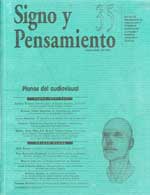Abstract
Este artículo es un acercamiento crítico a la película Goyescas del director español Beniro Perojo (1942). Según la autora, Goyescas es una película sobre el doble que a su vez representa el tema de la duplicidad, la identidad y la confusión. La autora parte del supuesto de que el "cine es un identificador de los puntos negros, de las incógnitas de una sociedad. No es una duplicación, sólo selecciona fragmentos y los ordena de cierta manera para darles sentido, esa cierta manera es el estilo, es decir, las formas expresivas, no sólo de un tiempo, sino de un director. (...) Es una mirada, en resumen, que revela mentalidades e ideologías, y define los límites visibles de una época, señalando las imágenes posibles de sí misma". Basada en Román Gubem, la autora parte de la hiótesis de que Goyescas es "una imagen espectacular de la realidad española en dos niveles: como producto total y como narración que en su interior guarda al mismo tiempo muchas duplicidades".This journal is registered under a Creative Commons Attribution 4.0 International Public License. Thus, this work may be reproduced, distributed, and publicly shared in digital format, as long as the names of the authors and Pontificia Universidad Javeriana are acknowledged. Others are allowed to quote, adapt, transform, auto-archive, republish, and create based on this material, for any purpose (even commercial ones), provided the authorship is duly acknowledged, a link to the original work is provided, and it is specified if changes have been made. Pontificia Universidad Javeriana does not hold the rights of published works and the authors are solely responsible for the contents of their works; they keep the moral, intellectual, privacy, and publicity rights.
Approving the intervention of the work (review, copy-editing, translation, layout) and the following outreach, are granted through an use license and not through an assignment of rights. This means the journal and Pontificia Universidad Javeriana cannot be held responsible for any ethical malpractice by the authors. As a consequence of the protection granted by the use license, the journal is not required to publish recantations or modify information already published, unless the errata stems from the editorial management process. Publishing contents in this journal does not generate royalties for contributors.


